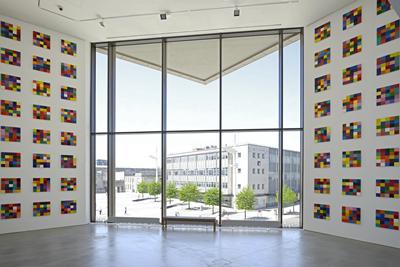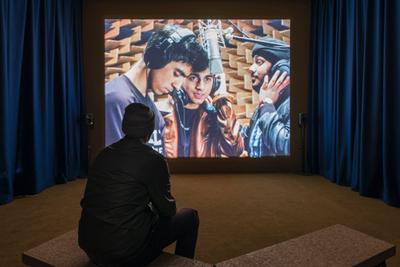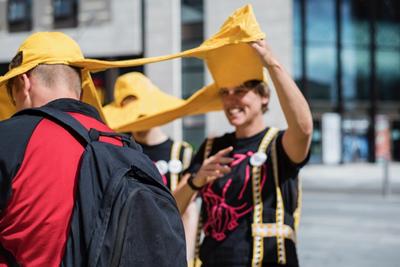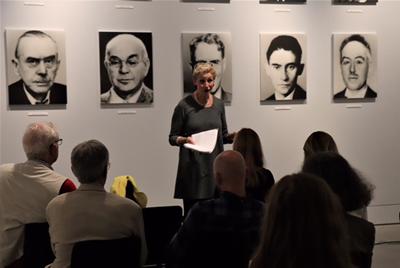University committed to ‘animating the city of Southampton’ through inspired arts and culture

The University of Southampton has reaffirmed its commitment to arts, culture and creativity through a new Arts Strategy (2018-22).
At the heart of the strategy is the University’s pledge to continue to contribute to Southampton’s growing cultural reputation, and to “animate the city” through its inspiring arts and culture programme.
Louise Coysh, Associate Director, Arts and Culture said: “The University of Southampton’s arts and culture programme enriches people’s lives, giving opportunities for discovery, increasing engagement, connectivity and wellbeing for our students, staff and diverse communities. These activities are at the heart of what we do as a University and they remain as a focal point of our new arts strategy.”
Professor Sir Christopher Snowden, the University’s President and Vice-Chancellor said: The University of Southampton has a strong history of cultural patronage and it is our belief that the arts have the power to enrich all our lives and deepen our sense of community which this new strategy both underlines and underpins. Our ongoing legacy has brought us inspiring new experiences, introduced us to the work of outstanding international artists and created opportunities to nurture the talent of our students, our staff and the local community which will continue to be a focal point for our activities for many more years to come.

Arts legacy to continue
Over many decades, the University of Southampton has developed and nurtured a pioneering history of cultural patronage through the arts, theatre and music, playing host to some of the city’s most respected and renowned venues. The institution is also home to a research-active Arts and Humanities Faculty encompassing the Winchester School of Art, as well as a successful and well-connected multidisciplinary Public Engagement with Research Unit, and over 40 performing arts student societies.
The recent collaborative performance project ‘SWEET TOOTH’ by acclaimed vocal artist Elaine Mitchener is an example of the strategy in action. The project sought to combine music and movement with research by University of Southampton historian Dr Christer Petley into the letters of Simon Taylor, a wealthy British Jamaican slaveholding sugar planter, written between 1765-1813, to explore our love of sugar and the historical links between the UK sugar industry and the Transatlantic Slave Trade.
A further successful collaboration between the University-based Turner Sims concert hall, Southampton Music Hub and Chineke!, Europe’s first professional majority Black and Minority Ethnic (BME) orchestra, resulted in an extraordinary musical performance involving school pupils from across the city of Southampton.

John Hansard Gallery vital to strategy’s success
Woodrow Kernohan, Director of the University’s John Hansard Gallery, a vital element of the strategy’s success, commented: “John Hansard Gallery has just relocated to our new purpose built space in Southampton’s Cultural Quarter. In May 2018, Sir Nicholas Serota, Chair of Arts Council England, officially launched our reopening exhibition by Gerhard Richter, one of the world’s most celebrated living artists.
“With additional support from University of Southampton and Arts Council England, the Gallery has unveiled its new public-facing approach, actively connecting with audiences through learning, interaction and participation,” Kernohan continued. “Throughout 2018-2019 the Gallery is working with artist collective Stair/Slide/Space to playfully engage with audiences alongside all the incredible exhibitions during our reopening year. We are also creating ‘Your Voices’, a community panel to ensure that our audiences’ voices are heard and present within all our activities. And JHG Beacons and Ambassadors schemes will create professional opportunities for young people to explore working in the arts.”
“Our arts and culture programme is locally relevant and internationally acclaimed and we want that reputation to continue flourish,” Ms Coysh emphasised. “We attract leading national and international talent - from our students and staff to the artists we work with and we will continue to support high quality, innovative and interdisciplinary practices that bring together artists with pioneering researchers in a unique creative environment.

Turner Sims sets stage for future collaboration
Our promoted concert series has for more than 40 years brought outstanding music and musicians to the city, from internationally-renowned artists to rising stars. The recently announced Autumn 2018 features jazz, world, folk, and classical artists including 2018 Classic Brit Award winner Jess Gillam, legendary musician and author Alfred Brendel, jazz pianist Tord Gustavsen, and folk singer Cara Dillon.
At the heart of our approach is the opportunity to engage diverse audiences with music. ‘The Jazz Ticket’, our collaboration with jazz collective Tomorrow’s Warriors, began in Southampton and then toured to six cities throughout 2017 involving 54 schools and 600 young people. SON, Southampton’s professional orchestra, and one of our newly announced Associate Artists, have pioneered a different approach to the concert format with their ‘Unwrapped’ series. And with the soon to be launched Jazz South project, supported by Arts Council England and the University, we will be supporting talent development across the region, ensuring greater ambition and access to high quality music.
“Our arts strategy is also focused on continually improving the career prospects of our students through professional development opportunities and workplace placements which arise through our collegiate and pro-active partnership activities with a wide range of organisations,” Ms Coysh concluded. “A number of our students have recently become Arts Ambassadors which is another important programme to support their career progression whilst raising the profile of the University’s arts activities throughout the student community.”